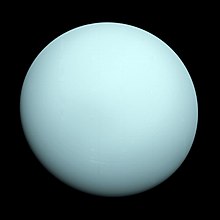Uranus
Uranus (seembol: ![]() ) is the seivent planet frae the Sun. It haes the third-lairgest planetary radius an fowerth-lairgest planetary mass in the Solar Seestem. Uranus is seemilar in composeetion tae Neptune, an baith are o different chemical composeetion than the lairger gas giants Jupiter an Saturn. For this reason, astronomers whiles place them in a separate category cried "ice giants". Uranus's atmosphere, altho seemilar tae Jupiter's an Saturn's in its primary composeetion o hydrogen an helium, contains mair "ices" sic as watter, ammonie, an methane, alang wi traces o hydrocarbons.[1] It is the cauldest planetary atmosphere in the Solar Seestem, wi a minimum temperatur o 49 K (−224.2 °C), an haes a complex, layered clood structur, wi watter thoucht tae mak up the lawest cloods, an methane the uppermost layer o cloods.[1] In contrast, the interior o Uranus is mainly componed o ices an rock.[2]
) is the seivent planet frae the Sun. It haes the third-lairgest planetary radius an fowerth-lairgest planetary mass in the Solar Seestem. Uranus is seemilar in composeetion tae Neptune, an baith are o different chemical composeetion than the lairger gas giants Jupiter an Saturn. For this reason, astronomers whiles place them in a separate category cried "ice giants". Uranus's atmosphere, altho seemilar tae Jupiter's an Saturn's in its primary composeetion o hydrogen an helium, contains mair "ices" sic as watter, ammonie, an methane, alang wi traces o hydrocarbons.[1] It is the cauldest planetary atmosphere in the Solar Seestem, wi a minimum temperatur o 49 K (−224.2 °C), an haes a complex, layered clood structur, wi watter thoucht tae mak up the lawest cloods, an methane the uppermost layer o cloods.[1] In contrast, the interior o Uranus is mainly componed o ices an rock.[2]

It is the anly planet whose name is derived frae a figure frae Greek mythology rather than Roman meethology lik the ither planets, frae the Latinized version o the Greek god o the sky, Ouranos. Lik the ither gas giants, Uranus haes a ring seestem, a magnetosphere, an numerous muins. The Uranian seestem heas a unique configuration amang the planets acause its axis o rotation is tiltit sideways, nearly intae the plane o its revolution aboot the Sun. Its north an sooth poles tharefore lie whaur maist ither planets hae thair equators.[3] In 1986, images frae Voyager 2 shawed Uranus as a virtually featurless planet in veesible licht wioot the clood bands or storms associated wi the ither giants.[3] Terrestrial observers hae seen signs o saisonal chynge an increased wather activity in recent years as Uranus approached its equinox. The wind speeds on Uranus can reach 250 meters per seicont (900 km/h, 560 mph).[4]
References
eedit- ↑ a b Lunine, Jonathan I. (September 1993). "The Atmospheres of Uranus and Neptune". Annual Review of Astronomy and Astrophysics. 31: 217–263. Bibcode:1993ARA&A..31..217L. doi:10.1146/annurev.aa.31.090193.001245.CS1 maint: ref=harv (link)
- ↑ Podolak, M.; Weizman, A.; Marley, M. (December 1995). "Comparative models of Uranus and Neptune". Planetary and Space Science. 43 (12): 1517–1522. Bibcode:1995P&SS...43.1517P. doi:10.1016/0032-0633(95)00061-5.
- ↑ a b Smith, B. A.; Soderblom, L. A.; Beebe, A.; Bliss, D.; Boyce, J. M.; Brahic, A.; Briggs, G. A.; Brown, R. H.; Collins, S. A. (4 Julie 1986). "Voyager 2 in the Uranian System: Imaging Science Results". Science. 233 (4759): 43–64. Bibcode:1986Sci...233...43S. doi:10.1126/science.233.4759.43. PMID 17812889.
- ↑ Sromovsky, L. A.; Fry, P. M. (December 2005). "Dynamics of cloud features on Uranus". Icarus. 179 (2): 459–484. Bibcode:2005Icar..179..459S. doi:10.1016/j.icarus.2005.07.022.CS1 maint: ref=harv (link)
Freemit airtins
eedit- Uranus at European Space Agency
- NASA's Uranus fact sheet
- Uranus Profile Archived 2007-06-24 at the Wayback Machine at NASA's Solar Seestem Exploration steid
- Planets – Uranus A kid's guide tae Uranus.
- Uranus at Jet Propulsion Laboratory's planetary photojournal. (photos)
- Voyager at Uranus Archived 2015-01-04 at the Wayback Machine (photos)
- Uranus (Astronomy Cast homepage) (blog)
- Uranian seestem montage (photo)